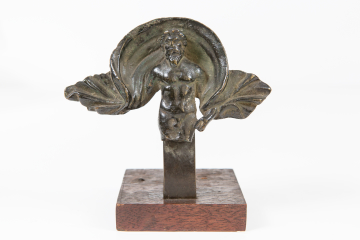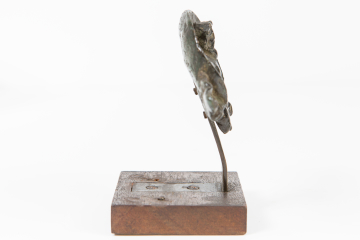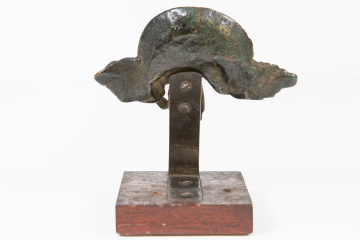Explore Collections


You are here:
CollectionsOnline
/
Statuette of Caelus (or Coelus), the Roman God of the sky / the heavens
Browse
Statuette of Caelus (or Coelus), the Roman God of the sky / the heavens
Undated
Bronze
Height (excluding base and mounting): 7cm
Width: 11cm
Width: 11cm
Museum number: A40
On display: Lobby to the Breakfast Room
All spaces are in No. 13 Lincoln's Inn Fields unless identified as in No. 12, Soane's first house.
For tours https://www.soane.org/your-visit
Curatorial note
Caelus stands(?) or emerges, nude, with a flowing beard and ample locks parted symmetrically in the middle, and holds with his extended right hand (hidden) and the left appearing at his side, a large cloak which whirls in a billowing curve from side to side, forming an enframement for the head.
Caelus, as god of the heavens themselves, was also used as a shorthand symbol for locality, actual or otherwise, and enjoyed great and diverse popularity and is used not only to personify the setting but often to fill otherwise unusable space. As such, in a figure similar to this one and springing from clouds, Caelus appears in the Apotheosis of Aeneas or Caesar (?) relief on the Belvedere altar1. The same half-figure of Caelus holding his mantle about his head, as in this Soane bronze, dominates the composition on the breastplate or cuirass of the statue of Augustus from the Prima Porta villa and also in the Vatican2. Caelus further appears, as a half-figure in a conventional pose, on the left side of a sarcophagus lid or a section of relief (?) in the same collections3. Here, like Tellus beside him, he is the abbreviated symbol for the (Earth and) Heavens over which Sol in his quadriga (chariot drawn by four horses) rides and the Capitoline Triad reigns. On a relief fragment in Berlin4, the kneeling(?) half-figure of Caelus fills the space between the base and the enthroned Zeus as both the customary symbol and the support for the clouds on which the divine action is represented. The freestanding counterpart of the Soane bronze is a Roman marble statuette also in Berlin5 where the god is kneeling and drawing the cloak in the characteristic gesture.
We also find Caelus in his traditional, half-figured pose in late antiquity beneath the symbolic enthronement of Our Lord in the upper front centre panel of the sarcophagus of Junius Bassus, 359 AD, in the crypt of St. Peter's in Rome6. He also appears in similar, symbolic role on another well known fourth century Sarcophagus in the Lateran Museum in Rome7.
This suggestion for Caelus as support of the divine heavens in late antique sarcophagi derives from the older, pagan tradition in the same medium, as on the Judgement of Paris sarcophagus in the Villa Medici where he emerges from the clouds and uses his whirling or billowing cloak to sustain the area on which the gods appear8. For a bibliography of Caelus on funerary and other monuments in association with companion divinities of locality, see Cumont9.
The female pendant to Caelus is Aura, who also wears the swirled cloak of the firment behind her head. As such she is seen in the large, very high relief of the sculptured pillar from the "Portique des Incantades" in Salonika, now in the Louvre in Paris10 - which is late second or early third century work, and a bronze statuette, also in the Louvre11. This arrangement of the cloak is also used in Roman sculpture to indicate rapid, divine motion in the figure of Pluto in a quadriga on a Rape of Prosepina sarcophagus seen in the Palazzo Barberini12.
1 Amelung, VC, II pp. 242-247, esp. 243, 246, no. 876, pl. 15 and bibliography; Röm. Mitt., 1907, p. 300; Reinach, RR, III, p. 398, fig. 3.
2 Amelung, VC, I, p. 21, no. 14, pl. 2; Gusman, AD, I, pl. 29.
3 Amelung, VC, II, pp. 688-690, no. 430, pl. 78; for interpretation, Cumont, Symolisme Funéraire, pl. III, 2, p.79.
4 Bes. Ant. Skulpt., p. 364f., no. 900, representing the Birth of Dionysos?.
5 Bes. Ant. Skulpt., p. 42, no. 82.
6 Paribeni, L'Italia Imperiale, p. 607, fig. 444; Ducati, L'Arte in Roma, pl. CCXXXV.
7 Ducati, op.cit., pl. CCXXXIII, 1; J.M.C. Toynbee, JRS, XXXXVII, 1947, p. 136, no 5.
8 Robert, Sark. Rel., II, pl. V, no. 11; Cagiano, Villa Medici, p. 68f., no. 54, pl. XXVIII, 43; there is curious "restored" baroque drawing of this relief in the dal Pozzo collection at Windsor, vol. A 47 (VIII), no. 8723, and a less bizarre rendering appears as Vol.I, fol. 222 of the dal Pozzo-Albani (Franks) drawings in the Greek and Roman Department of the British Museum.
9 op.cit., p. 85, n.1, also p. 171f., fig. 34.
10 No. 1393; Reinach, RR. I, p. 395, no. 2, on the pillar opposite Dionysos.
11 De Ridder, Louvre Bronzes, I, p. 104, no. 761 and bibl.
12 Reinach, RR, III, p. 159, no. 1, etc.; Ashmole, Ince, p. 104, no. 281, for description.
Caelus, as god of the heavens themselves, was also used as a shorthand symbol for locality, actual or otherwise, and enjoyed great and diverse popularity and is used not only to personify the setting but often to fill otherwise unusable space. As such, in a figure similar to this one and springing from clouds, Caelus appears in the Apotheosis of Aeneas or Caesar (?) relief on the Belvedere altar1. The same half-figure of Caelus holding his mantle about his head, as in this Soane bronze, dominates the composition on the breastplate or cuirass of the statue of Augustus from the Prima Porta villa and also in the Vatican2. Caelus further appears, as a half-figure in a conventional pose, on the left side of a sarcophagus lid or a section of relief (?) in the same collections3. Here, like Tellus beside him, he is the abbreviated symbol for the (Earth and) Heavens over which Sol in his quadriga (chariot drawn by four horses) rides and the Capitoline Triad reigns. On a relief fragment in Berlin4, the kneeling(?) half-figure of Caelus fills the space between the base and the enthroned Zeus as both the customary symbol and the support for the clouds on which the divine action is represented. The freestanding counterpart of the Soane bronze is a Roman marble statuette also in Berlin5 where the god is kneeling and drawing the cloak in the characteristic gesture.
We also find Caelus in his traditional, half-figured pose in late antiquity beneath the symbolic enthronement of Our Lord in the upper front centre panel of the sarcophagus of Junius Bassus, 359 AD, in the crypt of St. Peter's in Rome6. He also appears in similar, symbolic role on another well known fourth century Sarcophagus in the Lateran Museum in Rome7.
This suggestion for Caelus as support of the divine heavens in late antique sarcophagi derives from the older, pagan tradition in the same medium, as on the Judgement of Paris sarcophagus in the Villa Medici where he emerges from the clouds and uses his whirling or billowing cloak to sustain the area on which the gods appear8. For a bibliography of Caelus on funerary and other monuments in association with companion divinities of locality, see Cumont9.
The female pendant to Caelus is Aura, who also wears the swirled cloak of the firment behind her head. As such she is seen in the large, very high relief of the sculptured pillar from the "Portique des Incantades" in Salonika, now in the Louvre in Paris10 - which is late second or early third century work, and a bronze statuette, also in the Louvre11. This arrangement of the cloak is also used in Roman sculpture to indicate rapid, divine motion in the figure of Pluto in a quadriga on a Rape of Prosepina sarcophagus seen in the Palazzo Barberini12.
1 Amelung, VC, II pp. 242-247, esp. 243, 246, no. 876, pl. 15 and bibliography; Röm. Mitt., 1907, p. 300; Reinach, RR, III, p. 398, fig. 3.
2 Amelung, VC, I, p. 21, no. 14, pl. 2; Gusman, AD, I, pl. 29.
3 Amelung, VC, II, pp. 688-690, no. 430, pl. 78; for interpretation, Cumont, Symolisme Funéraire, pl. III, 2, p.79.
4 Bes. Ant. Skulpt., p. 364f., no. 900, representing the Birth of Dionysos?.
5 Bes. Ant. Skulpt., p. 42, no. 82.
6 Paribeni, L'Italia Imperiale, p. 607, fig. 444; Ducati, L'Arte in Roma, pl. CCXXXV.
7 Ducati, op.cit., pl. CCXXXIII, 1; J.M.C. Toynbee, JRS, XXXXVII, 1947, p. 136, no 5.
8 Robert, Sark. Rel., II, pl. V, no. 11; Cagiano, Villa Medici, p. 68f., no. 54, pl. XXVIII, 43; there is curious "restored" baroque drawing of this relief in the dal Pozzo collection at Windsor, vol. A 47 (VIII), no. 8723, and a less bizarre rendering appears as Vol.I, fol. 222 of the dal Pozzo-Albani (Franks) drawings in the Greek and Roman Department of the British Museum.
9 op.cit., p. 85, n.1, also p. 171f., fig. 34.
10 No. 1393; Reinach, RR. I, p. 395, no. 2, on the pillar opposite Dionysos.
11 De Ridder, Louvre Bronzes, I, p. 104, no. 761 and bibl.
12 Reinach, RR, III, p. 159, no. 1, etc.; Ashmole, Ince, p. 104, no. 281, for description.
Purchased by Soane at the Richard Cosway Sale (Mr. Stanley), 22 May 1821, Lot 63, for £2.6.3. On the base is a paper label inscribed 23 May, 1821, from Mr. Cosway.
Soane collections online is being continually updated. If you wish to find out more or if you have any further information about this object please contact us: worksofart@soane.org.uk









